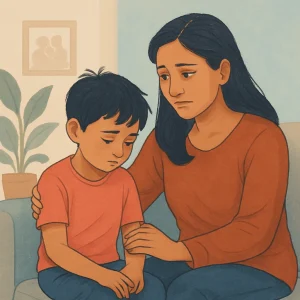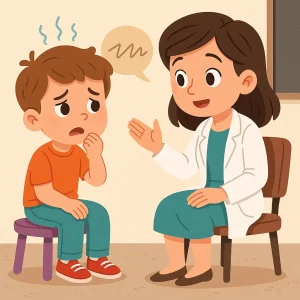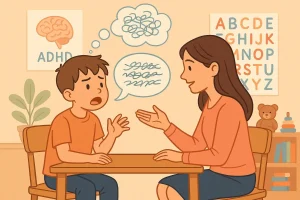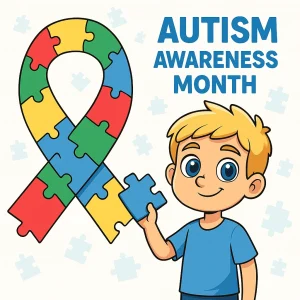Why Do Some People Have Slurred or Slow Speech?
By Rajini D
Last Updated: April 8, 2025
Have you ever noticed someone’s speech sounding unusually slow or slurred? This speech pattern might not just be a result of tiredness or temporary conditions—it could be a sign of a medical condition known as dysarthria. Dysarthria occurs when the muscles you use for speech are weak or you have difficulty controlling them. It can make it hard for a person to speak clearly, affecting how they articulate words, modulate their tone, or even control the volume and rhythm of their speech.
Understanding why some people develop dysarthria is crucial, not just for medical professionals, but for anyone who might encounter it in everyday life. By identifying the causes, we can better support those affected through early diagnosis, appropriate treatment, and effective management strategies. So, let’s dive into what causes this condition and how increased awareness can lead to better outcomes for those impacted.
What is Dysarthria?
Dysarthria is a speech disorder that occurs when the muscles you use for speaking are weak or difficult to control. This condition not only affects your ability to speak clearly but also impacts how you form words, control your voice pitch, and even maintain a regular speaking rhythm. Essentially, dysarthria can make it challenging for someone to communicate effectively with others, often leading to frustration and misunderstanding.
Also read: Understanding Dysarthria: Symptoms, Causes and Care
Symptoms of Dysarthria
The symptoms of dysarthria can vary widely depending on the underlying cause and the severity of muscle weakness or control. Common signs include:
- Slurred or slow speech that can be difficult to understand
- Limited facial movements
- A voice that may sound soft or even whispery
- Rapid, choppy, or mumbled speech
- Abnormal rhythm and pitch in speech
- Changes in voice quality, such as breathiness or hoarseness
Types of Dysarthria
There are several types of dysarthria, each linked to different causes and characteristics:
- Flaccid Dysarthria: Often results from nerve damage and is characterized by weak, floppy speech muscles.
- Spastic Dysarthria: Comes from muscle stiffness and results in harsh, strained speech.
- Ataxic Dysarthria: Related to a lack of coordination, affecting the timing and rhythm of speech.
- Hypokinetic Dysarthria: Associated with rigid muscles, typically seen in conditions like Parkinson’s disease.
- Hyperkinetic Dysarthria: Involves involuntary movements, affecting the consistency of speech.
- Mixed Dysarthria: A combination of types, reflecting symptoms of more than one form.
What Causes Slow Speech?
Slow speech often arises from different conditions than slurred speech, though there can be overlaps, especially in neurological diseases. Some of the typical reasons include:
- Muscular Disorders: Conditions like myasthenia gravis, which leads to muscle weakness, can slow down speech as the effort to talk increases.
- Neurodegenerative Diseases: Diseases such as Parkinson’s not only cause rigidity and tremors but can also slow speech as the patient struggles with muscle control.
- Medication Side Effects: Certain medications, especially those affecting the central nervous system, can slow down cognitive processing speeds, impacting speech tempo.
Discover How We Can Help Your Child Speak Clearly – Learn More Today!
Top 10 Causes of Dysarthria
Dysarthria can stem from a variety of underlying conditions, each impacting speech in unique ways. Understanding these causes is essential for effective management and treatment. Here’s a closer look at the top ten causes of dysarthria:
Neurological Disorders
Many neurological disorders can impair speech by affecting the brain’s ability to control the muscles used in speaking. Stroke, for instance, is a common cause where a lack of blood flow to the brain leads to muscle control loss, resulting in slurred or slow speech.
Brain Injuries
Traumatic brain injuries (TBI) can cause dysarthria when areas of the brain responsible for motor control are damaged. This can lead to a range of speech disturbances, from mild slurring to severe communication difficulties.
Infections Affecting the Brain
Infections like encephalitis and meningitis can inflame the brain and its surrounding tissues, leading to neurological impairments that affect speech. These infections can disrupt normal speech patterns by damaging the areas that control motor functions.
Degenerative Diseases
Diseases such as Parkinson’s disease and Amyotrophic Lateral Sclerosis (ALS) progressively damage the nervous system. In Parkinson’s, the reduction in dopamine affects motor control, while ALS leads to the degeneration of motor neurons that control voluntary muscle movement, including speech.
Tumors in the Brain or Nervous System
Both benign and malignant tumors can press against or damage parts of the brain involved in speech production, leading to dysarthria. The location and size of the tumor significantly influence the type and severity of speech impairment.
Alcohol and Drug Abuse
Substance abuse, including alcohol and certain drugs, can affect speech by impairing neurological function or temporarily reducing motor skills, leading to slurred speech.
Toxic Exposure
Exposure to environmental toxins, such as heavy metals or industrial chemicals, can cause neurological damage that manifests as speech problems. Chronic exposure can lead to persistent speech difficulties.
Medication Side Effects
Some medications, particularly those that affect the central nervous system, can cause dysarthria as a side effect. Drugs used to treat psychiatric disorders or seizures, for example, might lead to slurred speech.
Muscle Weakness
Generalized muscle weakness, such as from muscular dystrophy or myasthenia gravis, can affect the muscles around the mouth and throat, making it hard to articulate words clearly.
Genetic Conditions
Certain genetic conditions can predispose individuals to dysarthria. For example, Huntington’s disease and certain types of muscular dystrophy, which are inherited disorders, can lead to speech impairments as part of their broader range of symptoms.
Overview of Dysarthria Causes and Their Effects
| Cause | How It Affects Speech |
|---|---|
| Neurological Disorders | Impairs brain’s motor control |
| Brain Injuries | Damages motor control areas |
| Brain Infections | Inflames/damages motor areas |
| Degenerative Diseases | Progressively impairs motor nerves |
| Tumors | Pressure or damage to brain |
| Substance Abuse | Impairs neurological function |
| Toxic Exposure | Leads to neurological damage |
| Medication Side Effects | Impairs nerve function |
| Muscle Weakness | Weakens speech muscles |
| Genetic Conditions | Inherited motor control issues |
Living with Dysarthria: Tips and Support
Living with dysarthria can be challenging, not just for the individuals directly affected, but also for their families and friends. Effective communication is a cornerstone of daily life, and when it’s compromised, it can impact relationships, self-esteem, and social interactions. However, with the right strategies and support, managing dysarthria becomes more manageable. Here are some practical tips and resources that can help.
Practical Tips for Individuals and Families
- Enhance Communication:
- Use gestures or writing to support verbal communication.
- Employ communication aids like speech-generating devices or apps.
- Keep conversations in quieter environments to reduce background noise.
- Speech Therapy:
- Regular sessions with a speech-language pathologist (SLP) can significantly improve articulation and communication skills.
- Practice exercises recommended by an SLP at home to strengthen muscles and improve speech clarity.
- Patient Education:
- Learn as much as possible about dysarthria and its underlying causes. Understanding the condition helps in managing expectations and treatment.
- Support Groups:
- Join support groups where you can connect with others facing similar challenges. Sharing experiences and tips can be incredibly uplifting.
- Family Involvement:
- Encourage family members to be part of therapy sessions to understand how they can support communication efforts at home.
- Patience and understanding from family and friends are crucial. They should give the person ample time to speak without feeling rushed.
- Adaptive Techniques:
- Modify the home environment to facilitate easier communication, like having commonly used items within easy reach or using adaptive technology.
Conclusion
Understanding dysarthria is key to managing it effectively. Knowing what causes this speech disorder helps tailor treatments that improve communication. At Wellness Hub, we offer resources, expert advice, and a community that supports those affected. We encourage anyone struggling with speech difficulties to seek professional help. Our experts are ready to assist with personalized therapies that can greatly enhance daily communication. Visit our speech therapy services page to learn more and get the support you need. Remember, with the right help, improving your speech is very possible!
Frequently Asked Questions:
1. What is dysarthria in simple terms?
Dysarthria is a speech disorder that happens when the muscles used for speaking are either weak or have difficulty coordinating. This makes speech sound slow, slurred, or unclear because the speaker can’t control their mouth and voice muscles well.
2. What causes dysarthria in children?
In children, dysarthria can be caused by several conditions, including neurological disorders (like cerebral palsy or muscular dystrophy), brain injuries (from accidents or near-drowning), infections that affect the brain (like meningitis), or genetic conditions. Each of these causes affects how the brain and nerves control the muscles needed for speech.
3. Can dysarthria be treated?
Yes, treatment for dysarthria usually involves speech therapy to strengthen the muscles and improve control. Sometimes medications are used to treat underlying conditions, and in rare cases, surgery may be necessary. The type of treatment depends on the cause and severity of the dysarthria.
4. How can I help my child with dysarthria at home?
You can support your child at home by practicing speech exercises provided by a speech therapist, using communication aids (like speech-generating devices), and creating a calm environment to help them speak more easily. Encouragement and patience are also key in helping them improve their communication skills.
5. Is dysarthria the same as a stutter?
No, dysarthria and stuttering are different. Dysarthria is due to muscle control issues that make speech slow or slurred, while stuttering is characterized by interruptions in the flow of speech, such as repeating or prolonging sounds.
6. What are the first signs of dysarthria?
The first signs of dysarthria can include speaking more slowly than usual, slurring words, having a hard time moving the mouth to speak, and changes in the quality of the voice, like sounding hoarse or breathy.
7. Can dysarthria go away on its own?
Dysarthria typically does not improve without treatment, especially if it’s due to a neurological condition or brain injury. Effective management often requires ongoing speech therapy and treatment of any underlying medical issues.
8. What professionals should I consult for my child’s dysarthria?
For dysarthria, it’s important to consult a speech-language pathologist, who specializes in treating speech disorders. Depending on the cause, you might also need to see a neurologist, a pediatrician, or other specialists who can address the underlying health issues.
9 How does dysarthria affect a child’s education?
Dysarthria can impact a child’s ability to communicate, which might affect their social interactions and academic performance. Schools can provide accommodations, like speech therapy during school hours, assistive technology, and tailored learning plans to support the child’s education.
10. Where can I find resources for dysarthria?
You can find a wealth of resources on dysarthria at Wellness Hub. Our site offers educational articles, guides on therapy practices, and access to professional advice. Visit our resource center at My Wellness Hub’s resource center for more information and support.
About the Author:
Rajini Darugupally
M.Sc., Speech-Language Pathologist (9+ years of experience)
Rajini is a passionate and dedicated Speech-Language Pathologist with over 9+ years of experience, specializing in both developmental speech and language disorders in children and rehabilitation in adults. Driven by a desire to empower each individual to find their voice, Rajini brings a wealth of experience and a warm, genuine approach to therapy. Currently, at Wellness Hub, she thrives in a team environment that values innovation, compassion, and achieving results for their clients.
Book your Free Consultation Today
Parent/Caregiver Info:
Client’s Details:
* Error Message








